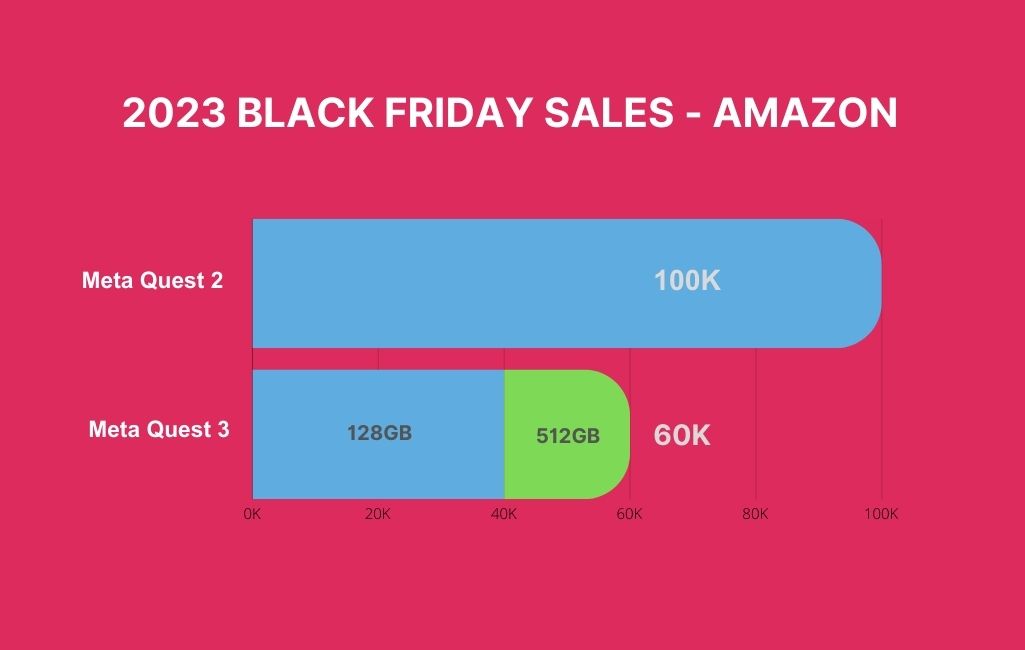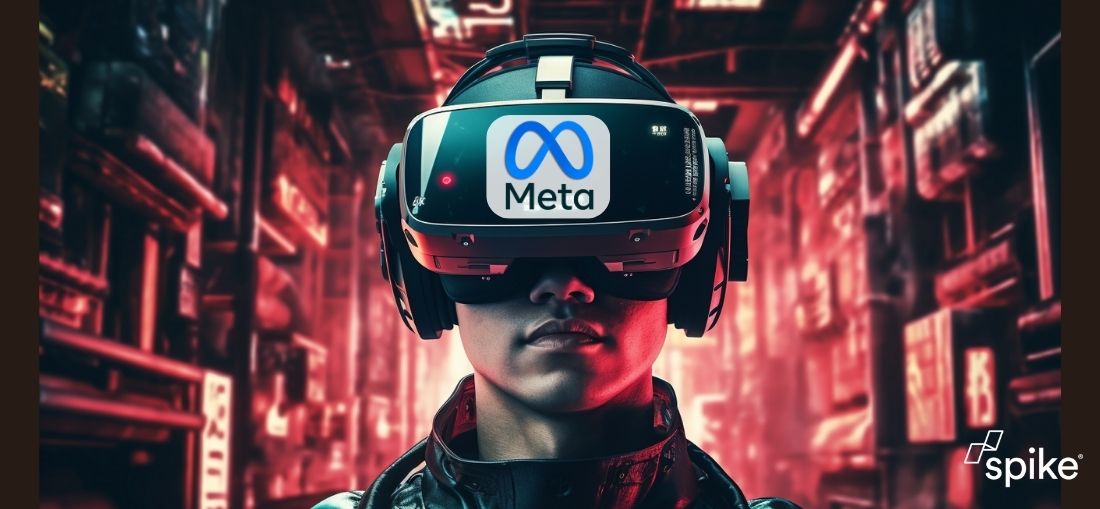Although Meta is reportedly spending billions of dollars per quarter building the metaverse, which Mark Zuckerberg believes is the future of his company, sales of VR headsets and AR glasses in the U.S. have plummeted nearly 40% in 2023.
However, in spite of these glum figures, Zuckerberg’s dream of a futuristic virtual reality world is undimmed, and the company remains as committed to the metaverse project as ever.
So, what’s happened, why is Meta’s project not getting off the ground and what challenges will the company face from the likes of Apple in 2024 and beyond? Let’s take a look.
What do the stats say?
Research from Circana has shown that sales of VR headsets and augmented reality glasses in the U.S. plummeted nearly 40% in 2023 to $664 million. This is the second consecutive year-on-year decline in sales. In 2022, sales of AR and VR devices slid 2% to $1.1 billion.
Alarmingly for Meta, these stats show that not only is the drop in sales continuing, but it’s also quickening.
Why is Meta struggling?
This two-year decline showcases just how much Meta is struggling to convert VR, which is typically seen as a niche gaming product, into the mainstream.
When announcing Facebook’s pivot to Meta back in 2021, Zuckerberg said that it would take a decade for the company to reach a billion users. However, progress has been painfully slow ever since and the company has made several hefty and risky investments that are yet to show real results.
Take Meta’s Reality Labs unit, for example. Reality Labs is responsible for developing the VR and AR technologies that should be central to Zuckerberg’s vision. However, rather than creating products that are attracting new users, in the third quarter of 2023, Reality Labs lost $3.7 billion on sales of only $210 million. Since the beginning of 2022, shortly after the company was rebranded as Meta and Zuckerberg set out his vision, Reality Labs has reportedly lost around $25 billion.
Of course, short-term losses are to be expected when building AR and VR products, and we certainly wouldn’t expect Reality Labs to be an overnight success. After all, Meta itself refers to AI and the metaverse as ‘two long-term bets on technologies of the future’.
From Meta’s perspective, the company seems fairly content with the idea that the metaverse will not be cheap to build. In this regard, Meta seems focused on the long-term benefits of the project, arguing that making long-term bets on emerging technologies is ‘one of the most valuable things a technology company can do — and the only way to remain relevant over the long run.’
Meta’s standing in the AR and VR markets
The good news for the company is that Meta remains the leader in the VR market. In fact, sales of the company’s Quest-branded headsets represent the bulk of the U.S. market by a large margin.
Sony, Meta’s main challenger in the space at present, is still struggling to make an impression. The company released its second-generation PlayStation VR2 headset earlier this year, but hasn’t picked up much market share due to the device’s reliance on the PlayStation 5 video game console.
By contrast, Meta debuted the Quest 3 in October. Despite the product costing $499 ($200 more than its predecessor’s base model), sales have been strong and the company has been credited with lifting the VR market during the pivotal holiday period. ZDNet reported that data based on Black Friday sales on Amazon alone, the Quest sold over 160,000 units, across both models (see below)

data courtesy of ZDNet
Additionally, during an eight-week period that spanned October and November, sales of VR headsets in the U.S. were $271 million, a 42% jump from the $191 million generated during the same period last year, Circana data showed.
That said, Meta’s dominance in the market will not go unchallenged for long and Apple’s eagerly anticipated Vision Pro mixed reality headset will hit the U.S. market in February 2024.
Priced at a reported $3,499, this will be a premium product that will likely target early adopters, developers and companies as potential customers. Despite the fact it won’t lead to mass adaptation, VR enthusiasts are excited about Apple’s first headset. This is unsurprising. After all, the company has an excellent track record with consumer devices and Vision Pro could integrate with other Apple products, such as the iPhone.
What does 2024 have in store for AR and VR?
For its part, Meta hopes that the Quest 3 will inspire developers to create compelling apps and games that utilise the device’s so-called passthrough feature, which allows for augmented reality experiences that mix digital graphics with real-world experiences. Developers have said that the Quest 3 is an upgrade on the Quest 2 in this regard, and Meta says that seven of the top 20 apps are already mixed reality apps.
However, the release of the Vision Pro could scupper Meta’s plans and challenge the company’s market dominance. That said, although Apple is creating a rival product for Meta to be concerned about, the Vision Pro could also help bolster the fledgling and struggling VR and AR market.
There are, of course, differences between Meta and Apple’s products. For example, Meta’s Quest 3 is more game-focused than Apple’s Vision Pro, which is more of a lifestyle device that will allow for entertainment-friendly uses like the ability to watch movies on a giant virtual display. For its part, Apple describes the Vision Pro as a ‘spatial computer’ that’s capable of blending the physical world with digital content and visuals.
The Vision Pro (as the price point suggests) is also a much more premium product than the Quest 3, so we will likely soon learn a lot more about what an ultra-premium VR experience looks like and what the associated use cases can be.
By comparison, Meta is aiming for mass market appeal with the Quest 3. Plus, there’s also the potential for this device to be used in businesses, where it can be useful for workforce training, onboarding and marketing. After all, the Quest 3 is $500 cheaper than the Quest Pro, which was released in 2022 as more of a business-focused device, and has many of the same features. Meta has also previously enjoyed a great amount of success in the business space and rivals Taiwan’s HTC for market share already.
But, can Meta make the Quest 3 appeal to more people than just early adopters and hardcore gamers? The jury remains out on whether they can make the $500 fee for the headset worthwhile.
Why is this important?
A lot has been said recently about the battle for dominance in the AI space. As arguably the biggest marketing trend of 2023, this is undoubtedly an important discussion. However, in the coming years, VR and AR could be just as influential in changing the way we work, play and communicate.
So, the news that the AR and VR market is stagnant at the moment is highly significant. As is the news that Meta’s market dominance will soon be challenged by Apple.
The release of the Vision Pro in February 2024 will likely tell us a lot about the future of the AR and VR markets. Will this high-end option provide a big pull? Or will Meta find a new way of bringing more users to its $500 product so that the company can make Mark Zuckerberg’s dream a reality? We don’t have long to wait to find out.
Tom Brook
When he's not crafting content, Tom's obsessed with all things sport, particularly football, cricket, golf and F1.
